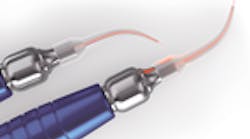Implementing lasers as an adjunct to nonsurgical periodontal treatment has been shown to help the 47% of adults over age 30 who have chronic periodontitis.
The use of lasers as an adjunct in dentistry is favored by some and scoffed at by others. Even more have no opinion due to a lack of knowledge. Determining where you stand on the use of lasers in dentistry can change over time with developments in technology and understanding. Even though literature varies with regard to the efficacy of lasers, there are a multitude of studies available for review that I will discuss in this article.
Depending on the need, a laser can serve many different purposes within a dental practice: cutting hard and soft tissues, whitening, removing oral lesions, treatment of herpetic lesions, and periodontal therapy. The acronym LASER stands for light amplification by stimulated emission of radiation, and the use of lasers in dentistry made its debut in 1960.1 With improvements in devices and affordability since that time, lasers have been implemented and embraced by many dental professionals.
In 1994, lasers gained FDA approval to be used in dentistry to treat hard and soft tissue within the oral cavity. Nd:YAG, Er:YAG, and carbon dioxide (CO2) lasers are indicated for hard and soft tissues and are more costly than the diode lasers that are used in hygiene. While hard tissue lasers can risk overheating the pulp of the tooth, they definitely serve a purpose in dentistry. Most are not used by hygienists, however. When using lasers, cavity preparations and soft tissue biopsies can be performed with less bleeding and trauma than a surgical incision, and lasers also enable procedures such as crown lengthening and frenectomies to be performed quickly, as they cauterize for minimal bleeding.
Then along came the diode laser that changed the way many practice dental hygiene. Diode lasers are generally what we find in the hands of dental hygienists for the purposes of periodontal treatment and a tool to treat inflammation. The implementation of the more affordable diode laser with a wavelength that is absorbed into the pigment and hemoglobin allows for improved wound healing.1 Studies indicate that low-level laser treatment activates the fibroblasts in as few as 24 hours after treatment.1
Another study shows marked improvement in patients who had periodontal treatment with diode laser therapy.2 The study consisted of one control site versus a test site, with patients having the same periodontal treatment but with adjunctive diode laser therapy. Patients were given posttreatment assessments after two weeks and then again at two months. In most cases, the test site treated with the diode laser showed a noted improvement in pocket depths, gingival index, and clinical attachment loss, in addition to lesser recolonization of the anaerobic gram-negative microbes, versus that of the control site.2 This is just one of many studies showing the efficacy of using lasers as an adjunct to periodontal care.
I was introduced to the LANAP (laser-assisted new attachment procedure) protocol while working in a periodontal office that focused on treatment of periodontal disease through tissue regeneration. LANAP addresses inflammation and infection while taking into account the occlusion and osseous state of the periodontium. Part of the protocol includes the use of PerioLase, an Nd:YAG laser that is set to target the diseased epithelium within the periodontal pocket while not damaging the healthy tissue.
During the first year post–LANAP treatment, the patient’s tissue response is evaluated and cannot be probed so as not to disturb the healing periodontium. Only supragingival therapy can be done.3 As a hygienist of many years, I was able to experience a different method to treat severe periodontitis with great success. At subsequent periodontal maintenance visits, patients were treated with a diode laser as part of the process of bacterial reduction and to maintain the positive progress that had been achieved with LANAP. Patients who were reluctant to accept traditional cut-and-sew periodontal surgery were more willing to undergo LANAP. The laser leaves the noninfected tissue intact, as it only reacts to diseased tissue within the periodontal pocket.3 LANAP is not a one-size-fits-all therapy. Some patients are best served with traditional periodontal surgery; this decision is at the discretion of the periodontist.
The affordability of diode lasers in dentistry has gained traction as a reason to implement adjunctive procedures. The size and portability of the lasers currently on the market make them easy to use in any operatory. For example, a small, pen-sized laser (e.g., NV Pro3 Microlaser) or a small portable diode laser (e.g., Epic from Biolase) makes it easy to move from place to place.
As a freshly minted hygienist, I had the opportunity to become laser-certified, and I have worked with lasers off and on over the years. I have found the efficacy rewarding in patients who have been treated with lasers in conjunction with nonsurgical therapy versus those who haven’t. After initial treatment, we follow up with the therapeutic use of lasers for bacterial reduction in order to sustain periodontal health.
The Academy of Laser Dentistry is a resource that outlines the training criteria and education to ensure competency and safety when treating patients with lasers. Training and knowledge about the specific device you are using is imperative to safety and successful clinical outcomes. Thankfully many courses are offered throughout the country.
Currently there is no existing procedure code for the use of lasers in dentistry. The Code Maintenance Committee of the American Dental Association has been presented with code proposals many times in different formats. But proposals to create a CDT code for the adjunctive use of lasers have failed thus far. This hasn’t stopped various individuals and groups such as DentalCodeology Consortium (DCC), a large group of like-minded dental professionals led by Patti DiGangi, BS, RDH, from looking to change the CDT codes we have at our disposal. This grassroots group continues to work in alliance with other dental professionals to gain recognition of the benefits of laser therapy and lobby for a metric for measurement in future years. The closest CDT code many offices use for laser treatment as an adjunct to periodontal treatment is D4999 (“unspecified periodontal procedure, by report”), and some offices charge a nominal fee to patients. It is always important to make sure the patient understands that most insurance plans will not pay for laser service in dentistry; however, in my experience, patients are very willing to pay out of pocket. This provides a way for dental offices to recoup the cost of the laser device.
Implementing lasers as an adjunct to nonsurgical periodontal treatment has been shown to help the 47% of adults over age 30 who have chronic periodontitis.4 Laser therapy as an adjunct has been shown to be more effective than nonsurgical periodontal treatment alone.4 The benefits of using a laser go far beyond just periodontal treatment; they can also be used to alleviate the pain of aphthous ulcers and promote healing. While the dental laser is no magic cure, it can be a very valuable adjunct to your armamentarium, particularly when used in conjunction with nonsurgical periodontal treatment.
References
- Verma SK, Maheshwari S, Singh RK, Chaudhari PK. Laser in dentistry: an innovative tool in modern dental practice. Natl J Maxillofac Surg. 2012;3(2):124-132. doi:10.4103/0975-5950.111342
- Fenol A, Boban NC, Jayachandran P, Shereef M, Balakrishnan B, Lakshmi P. A qualitative analysis of periodontal pathogens in chronic periodontitis patients after nonsurgical periodontal therapy with and without diode laser disinfection using benzoyl-DL arginine-2-naphthylamide test: a randomized clinical trial. Contemp Clin Dent. 2018;9(3):382-387. doi:10.4103/ccd.ccd_116_18
- Gregg RH. The LANAP protocol: laser-assisted new attachment procedure. DentistryIQ. October 28, 2011. https://www.dentistryiq.com/dentistry/article/16358218/the-lanap-protocol-laserassisted-new-attachment-procedure
- Crispino A, Figliuzzi MM, Iovane C, et al. Effectiveness of a diode laser in addition to non-surgical periodontal therapy: study of intervention. Ann Stomatol (Roma). 2015;6(1):15-20.
Jamie Collins, RDH-EA, is a practicing clinical hygienist in Idaho and Washington states. She has been in the dental field for nearly 20 years, both as an assistant and a hygienist. With a passion for patient care, especially for those with higher risk factors, she enjoys sharing the tips and tricks of the dental profession through speaking and writing. In addition to being in clinical practice, she is an educator, has contributed to multiple textbooks and curriculum development, and is a key opinion leader. Contact her at [email protected].







